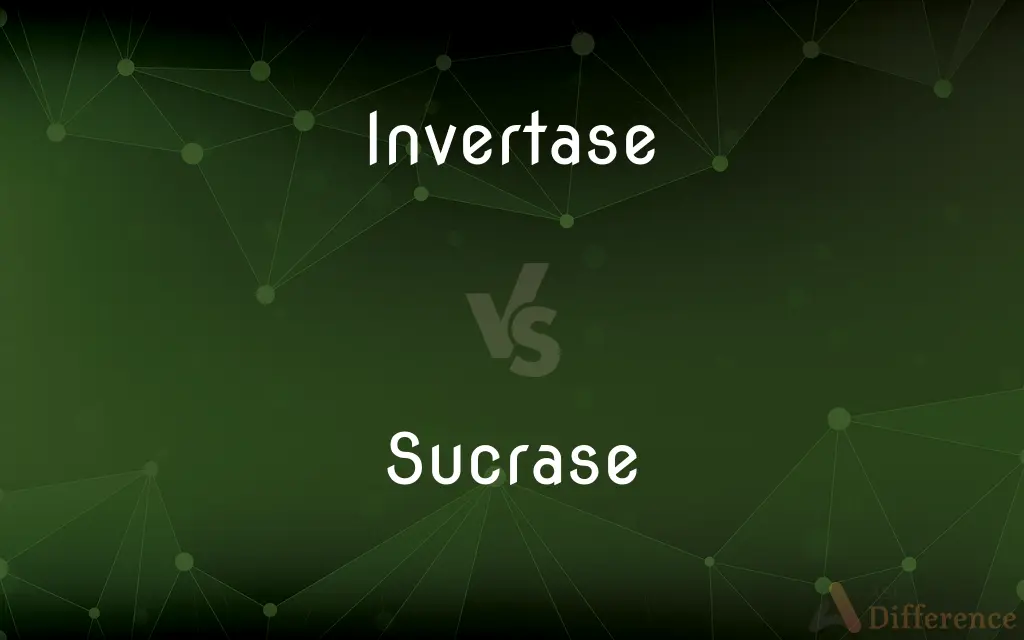Invertase vs. Sucrase — What's the Difference?
By Urooj Arif & Maham Liaqat — Updated on April 7, 2024
Invertase and sucrase both catalyze the hydrolysis of sucrose into glucose and fructose, but invertase is found in yeast and plants, while sucrase is a type of invertase present in the human small intestine.

Difference Between Invertase and Sucrase
Table of Contents
ADVERTISEMENT
Key Differences
Invertase is an enzyme found in yeast and plants that catalyzes the hydrolysis of sucrose into glucose and fructose, a key reaction in processes like fermentation. On the other hand, sucrase, specifically found in the human small intestine, is a type of invertase that plays a crucial role in the digestion of dietary sucrose, breaking it down into monosaccharides for absorption.
While invertase operates in a broad range of pH and temperature conditions suitable for plant and yeast environments, sucrase functions at the specific pH and temperature conditions found in the human small intestine, optimizing its activity for human digestion.
The applications of invertase include the food and beverage industry, where it is used to produce soft-centered candies and in the fermentation process of beer. In contrast, sucrase's application is primarily biological, facilitating the digestion and absorption of nutrients in humans.
In terms of specificity, invertase can act on sucrose in various conditions, making it versatile for industrial use. Sucrase, however, is designed to work efficiently within the narrow conditions of the human digestive system, ensuring the effective breakdown of dietary sucrose.
Despite these differences, both enzymes play essential roles in their respective domains—invertase in the industrial processing of foods and beverages and sucrase in the human digestive process, highlighting the diverse functionality of enzymes in biological and industrial contexts.
ADVERTISEMENT
Comparison Chart
Source
Found in yeast and plants.
Present in the human small intestine.
Function
Catalyzes the hydrolysis of sucrose into glucose and fructose.
Specifically aids in digesting sucrose in humans.
PH and Temperature
Broad range, suitable for various environments.
Optimized for human body conditions.
Applications
Used in food industry and fermentation.
Involved in human digestion.
Specificity
Versatile in industrial use.
Narrow, designed for the digestive system.
Compare with Definitions
Invertase
Food and Beverage Use.
Invertase is key in producing soft-centered chocolates and sweets.
Sucrase
Biological Role.
Sucrase's activity is crucial for the efficient digestion of carbohydrates in humans.
Invertase
Yeast and Plant Enzyme.
Invertase extracted from yeast is used to soften candy centers.
Sucrase
Specific Hydrolysis Function.
By converting sucrose to glucose and fructose, sucrase facilitates energy utilization.
Invertase
Industrial Applications.
Beer production utilizes invertase to convert sucrose into fermentable sugars.
Sucrase
Digestion and Absorption.
Without sucrase, humans would struggle to digest and absorb nutrients from sucrose.
Invertase
Catalyzes Hydrolysis.
Invertase breaks down sucrose into glucose and fructose, aiding in fermentation.
Sucrase
Human Digestive Enzyme.
Sucrase in the small intestine breaks down dietary sucrose for nutrient absorption.
Invertase
Broad Operating Range.
Invertase functions efficiently across a range of pH and temperatures.
Sucrase
Optimized for Body Conditions.
Sucrase operates best at the human body's internal pH and temperature.
Invertase
Invertase is an enzyme that catalyzes the hydrolysis (breakdown) of sucrose (table sugar) into fructose and glucose. Alternative names for invertase include EC 3.2.1.26, saccharase, glucosucrase, beta-h-fructosidase, beta-fructosidase, invertin, sucrase, maxinvert L 1000, fructosylinvertase, alkaline invertase, acid invertase, and the systematic name: beta-fructofuranosidase.
Sucrase
Sucrase is a digestive enzyme that catalyzes the hydrolysis of sucrose to its subunits fructose and glucose. One form, sucrase-isomaltase, is secreted in the small intestine on the brush border.
Invertase
An enzyme that catalyzes the hydrolysis of sucrose into glucose and fructose. Also called saccharase, sucrase.
Sucrase
See invertase.
Invertase
An enzyme that catalyzes the hydrolysis of sucrose into glucose and fructose (invert sugar), used by bees to produce honey and in the food industry to soften chocolate.
Sucrase
(enzyme) Any of a number of enzymes that catalyze the hydrolysis of sucrose to fructose and glucose or to their respective homopolysaccharides
Invertase
An enzyme capable of effecting the inversion of cane suger, producing invert sugar. It is found in many plants and in the intestines of animals.
Sucrase
An enzyme that catalyzes the hydrolysis of sucrose into glucose and fructose
Invertase
An enzyme that catalyzes the hydrolysis of sucrose into glucose and fructose
Common Curiosities
What is sucrase?
Sucrase is an enzyme in the human small intestine that hydrolyzes dietary sucrose into glucose and fructose for absorption.
Can invertase function in the human body like sucrase?
While both enzymes perform similar reactions, sucrase is optimized for the human digestive environment, making it more effective for digestion.
Are there industrial uses for sucrase?
Sucrase's primary function is biological, within human digestion, rather than industrial.
Is invertase used in all types of alcoholic fermentation?
Invertase is particularly used in brewing processes where sucrose needs to be broken down into fermentable sugars.
How do invertase and sucrase contribute to nutrition?
Invertase aids in food processing, enhancing flavors and textures, while sucrase directly supports human nutrition by digesting sucrose.
How do the pH and temperature preferences of these enzymes differ?
Invertase works across a broad range of conditions, while sucrase is optimized for the specific conditions of the human body.
Can people have a deficiency in sucrase?
Yes, sucrase deficiency can lead to difficulties digesting sucrose, resulting in gastrointestinal symptoms.
Can invertase be taken as a supplement?
Invertase can be found in certain dietary supplements, especially those aimed at improving digestion.
What is invertase?
Invertase is an enzyme that catalyzes the breakdown of sucrose into glucose and fructose, found in yeast and plants.
How do invertase and sucrase differ in source?
Invertase is derived from yeast and plants, whereas sucrase is specific to the human digestive system.
What are the applications of invertase?
Invertase is used in the food industry, particularly in candy manufacturing and fermentation processes.
Why is sucrase important for humans?
Sucrase is essential for the digestion and absorption of dietary sucrose, contributing to energy intake.
Is sucrase present in all humans?
Yes, sucrase is normally present in the intestines of all humans as a key enzyme for sugar digestion.
Are there synthetic forms of these enzymes?
Synthetic or industrially produced versions of these enzymes are available for use in food processing and research.
What happens if sucrase doesn't work properly in the body?
Inefficiencies in sucrase can lead to malabsorption of sugars, causing digestive issues.
Share Your Discovery

Previous Comparison
Osteectomy vs. Osteotomy
Next Comparison
Infanteer vs. InfantryAuthor Spotlight
Written by
Urooj ArifUrooj is a skilled content writer at Ask Difference, known for her exceptional ability to simplify complex topics into engaging and informative content. With a passion for research and a flair for clear, concise writing, she consistently delivers articles that resonate with our diverse audience.
Co-written by
Maham Liaqat














































